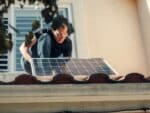The decision to make the switch to solar is not one to take lightly. If you have decided to add solar to your home, what comes next might be an even harder decision ahead of you. Let’s not mince words: solar can be an expensive option upfront. Especially if you are paying a company to do the installation.
While the panels and inverters can be a large chunk of money, labour costs can be extensive. On the other hand, designing your own system, sourcing components, and installing everything is a complicated task that most will be unable to do. It takes research, technical know-how, an understanding of safety and the risks inherent, and access to the appropriate equipment, to install solar yourself.
In this article, we will break down the options people consider when looking to make the switch to solar, as well as the different challenges that relate to each option.

The challenges related to installing solar
Solar is a complex installation where you will need to consider many factors. These types of informed decisions, combined with the fact that things can go very wrong whenever you are dealing with electricity, make us highly suggest that solar be installed professionally.
Some of the challenges that come with solar installation include:
- Panel placement, including the direction, angle, and size of space you will be able to put solar panels on
- Installation, which is often on a rooftop, or another raised structure, which could prove hazardous for falls.
- Sizing your system appropriately, including installing the right number of panels, sourcing a large enough inverter for your system, and potentially finding batteries that will provide the amount of necessary power.
- Securing the necessary permits.
- Working with your utility company for grid-tied systems.
The solar installation options
The three methods of installing solar are professional installation, installation kits, and DIY.
- Professional installation is going to be more expensive upfront, but all aspects of the installation are covered in most cases, including dealing with permitting and connecting to the grid.
- Installation kits combine some of the convenience of professional installation, but you are in charge of the labour yourself.
- DIY is what you make of it. Between the research and installation, it is the most complex, difficult choice. But for the right type of person, it may also prove the cheapest (in terms of dollars spent, time spent is another topic).

Professional installation
The most common way people are installing solar to their homes, hiring a professional company will cut out much of the labour you would otherwise need to perform, and simplify the research you will need to do, aside from getting quotes from the company and maintaining communication with them.
Professional installation covers all your bases. They do the permitting, they do the planning, they do the full installation. Many companies offer extended warranties, and support after the installation is complete, just in case something happens down the line.
However, with any professional installation, you need to know what you are getting. It is incredibly important to shop around for different quotes, so you can shop around for different systems that might have key differences in price, size, components, and design.
Professional installation is also way more likely to make your solar installation applicable for governmental incentives, such as loans or rebates. DIY installations rarely get these benefits, and so it could be more financially beneficial to opt for an installed solar set-up.
DIY Kits
With the inherent difficulty of DIY, some solar companies have tried to make it easier for handy people by bundling together the components required for a fully functioning grid-tied system including solar panels, inverters, mounting, monitor systems, and cables.
Some even will include battery options, if designed to be fitted to a smaller, off-grid application, like on an RV or a cabin.
DIY Kits give buyers the chance to save some of the money on the labour (which can contribute largely to the costs of a professionally installed system) while gaining some of the other benefits that make it a stronger option than going full DIY. Since these kits include “permit-ready plans”, they are ready to be installed and connected to the grid by an Electrical professional. These types of kits are often supported by a warranty.
DIY
In the true spirit of DIY, this calls for doing everything you can yourself, or by hiring the right people for each task if you cannot, including the sourcing of the components, the development of the schematics, the application of permits, and the full installation of your solar panels.
Some of these, like the application of permits, may not be possible for the layman to do themselves. Others, like the schematics, might also need to be designed by a professional electrician.
DIY is better implemented on smaller-scale projects, like (small projects) rather than on large projects like your rooftop, as DIY is the hardest and most complicated way to install solar.
If you have enough of a background in a related fields like solar, construction or electrician, or are handy enough and complex DIY jobs are something you regularly undertake, then your ambition might reward you, as long as you conduct ample research.
An improperly installed DIY system might not be able to be connected to the Grid, fail to pass an electrical inspection, or ignite a fire if something goes wrong.
The Advantages & Disadvantages
Installers
Pros: Easiest, ensured permit and warranty protection, don’t need to lift a finger except to call.
Cons: More expensive, can take a long time between getting a quote and installation, not all installers are trustworthy.
DIY kit
Pros: All-in-one purchase, no labour costs, schematics already planned out.
Cons: Requires labour and some technical skills.
Full DIY
Pros: Can be the cheapest if done right, good for off-grid setups.
Cons: Requires a lot of research, know-how, and technique.
How much energy does a solar panel produce?
The amount of energy a solar panel produces is heavily dependent on the amount of sunlight it receives. Different solar panels produce different amounts of electricity, listed in Watts, which will be listed within the name or information of the solar panel. Usually, the output rating will be between 200 and 400W, but this varies on the make and model of the solar module.
To find an estimate of Watt/hour, the amount of energy a solar panel could feasibly produce in a day, you will need to multiply the number of watts, the efficiency of the panels, and the average hours of sunlight per day for your area (which can easily be found by Googling it).
For example, a 400W panel with a 22% efficiency in Edmonton, Alberta, which over the course of the year, averages 6.3 hours of sunlight, could generate 554 W/h, or 0.55 kW/h. Keep in mind that winter months have much less sunlight per day than summer months, so you cannot expect this type of production year-round (but should blow past it on average during the summer).
How is solar energy converted to electricity?
According to the U.S. office of Energy Efficiency & Renewable Energy:
“When the sun shines onto a solar panel, energy from the sunlight is absorbed by the PV cells in the panel. This energy creates electrical charges that move in response to an internal electrical field in the cell, causing electricity to flow”
The resulting electricity is DC current, which then needs to be converted to AC current, via use of an inverter, before the appliances and electronic devices in your home can be powered by the generated electricity.
How is solar energy stored?
Solar energy is an intermittent power source – meaning that it generates energy inconsistently, i.e. only when the sun is shining. Solar panels have no inherent property that lets them store electricity for later use, so solar systems are either set up to connect to the electrical grid or are connected to some kind of battery.
The electrical grid – In a grid-tied system, your home is still connected to the power grid and you still have an agreement with an energy provider. In many areas, electricity utilities offer “net metering”, which is an agreement that will provide solar-owners credits in return for selling their unused electricity to the grid. These credits can be used to offset large amounts of your power bill, which can end up saving you money and paying off your solar panels in years. However, keep in mind that energy sold during the day can often be worth less than energy consumed at night.
Battery storage – By combining solar PV generation with a battery bank, you can generate electricity throughout the day, and store it for when you need to use it. However, keep in mind that batteries are often the most expensive part of any solar setup that needs them. For more information on batteries, read the article here.











